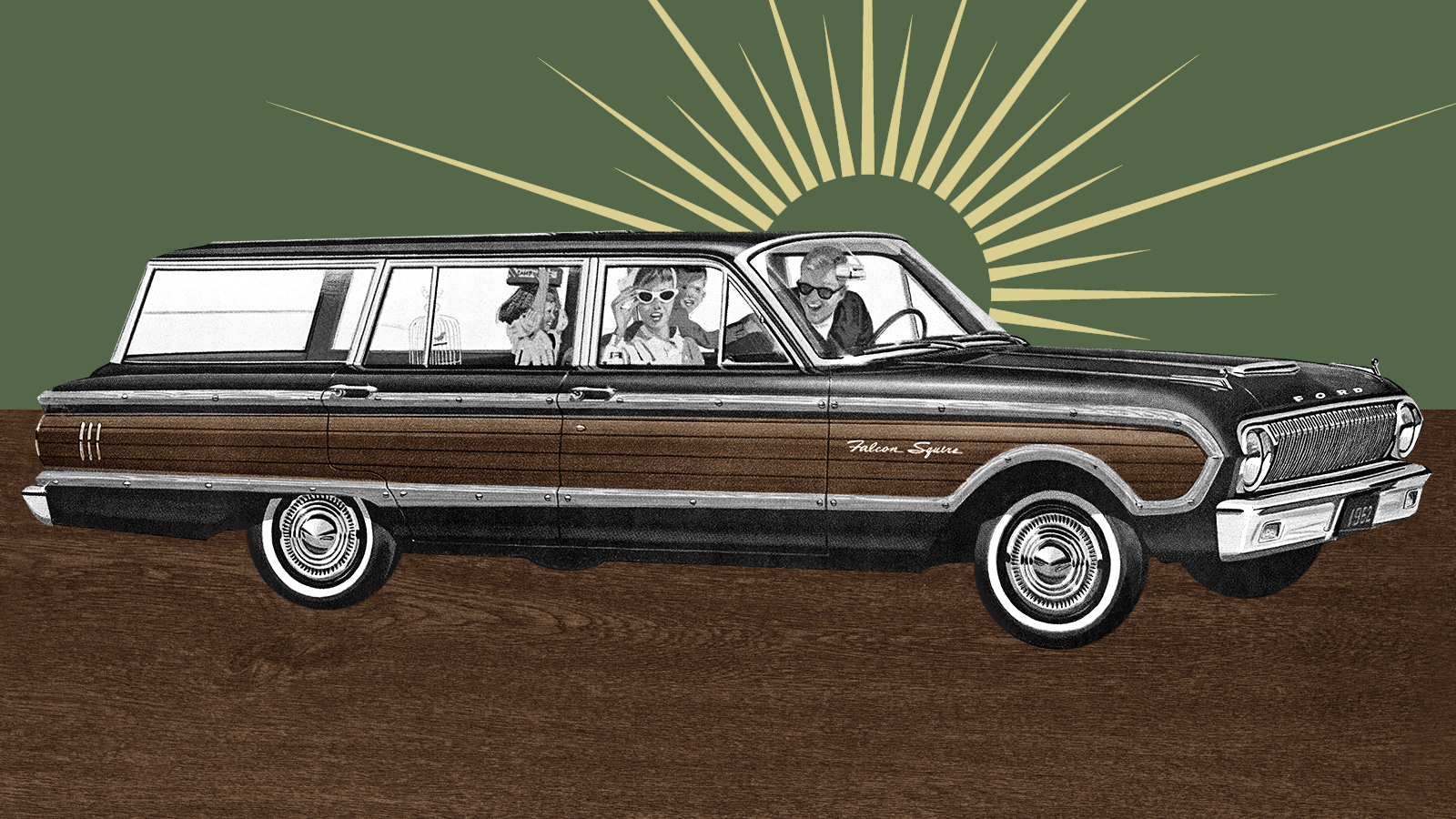Bring back the station wagon
How regulations helped push consumers and manufacturers to bigger, dirtier, dangerous vehicles


What looks like a land-boat, sports wood paneling, and does everything a large family needs in a vehicle? A station wagon, which you'll also have quite a lot of trouble buying new these days.
The humble station wagon, like an 800-square-foot house or a tiny motel room, was perfectly serviceable for generations of American families and road-trippers. But unlike those other things, there's really nothing inferior or outdated about it today.
The general derision roomy vehicles sometimes receive from car enthusiasts or urbanists is silly, and can evince a cluelessness about the needs of families. A sedan is unsuitable for a family of more than five, or for a two-family trip, or for a dog and more than two or three people. Any number of daily trip arrangements require something larger.
The Week
Escape your echo chamber. Get the facts behind the news, plus analysis from multiple perspectives.

Sign up for The Week's Free Newsletters
From our morning news briefing to a weekly Good News Newsletter, get the best of The Week delivered directly to your inbox.
From our morning news briefing to a weekly Good News Newsletter, get the best of The Week delivered directly to your inbox.
The station wagon, with its roomy trunk, wide interior, and seating, as in the now-collectible Buick Roadmaster Estate, for up to eight people (or fewer people plus equipment, bikes, or pets) clearly answered this demand. These vehicles boasted powerful engines and could weigh well into the 4,000-pound range. They resemble lower-rise minivans and function about the same, despite being essentially elongated sedans.
SUVs and minivans, which largely replaced wagons, are widely perceived as safer in crashes, given the driver's high position and the vehicle's overall mass. However, the SUV's safety benefits are less than many consumers think. They're more susceptible to rollovers due to a higher center of gravity, for example. The main benefit of an SUV in a crash is its heavy weight, which as mentioned above, many station wagons had too.
But heavy weight compared to what? Smaller cars. No less a car enthusiast than Shop Class as Soulcraft and Why We Drive author Matthew Crawford writes, on the rise of large SUVs, "we have been engaged in an arms race of vehicular mass." He also agrees with something that some studies have suggested: the perception of SUVs as very safe—safer than they really are—encourages inattentive or even reckless driving, a phenomenon akin to the "rebound effect" in energy economics. In short, SUVs are somewhat safer than sedans—but chiefly because of the danger posed to sedans by SUVs. Consumer Reports writes, "Just because a big, heavy vehicle has the advantage in a head-on with a smaller, lighter one, it doesn't mean that lighter vehicles are unsafe. In truth, they're safer than ever."
The lower profile of station wagons should also be an extremely important consideration in terms of safety. Along with speed and vehicle weight, the point at which a vehicle's front end meets a pedestrian determines how serious a pedestrian injury is likely to be. A sedan or a wagon, with a low-lying, sloped front end, will hit an average person below the waist, and sometimes send them up onto the hood or windshield. An SUV or minivan (not to mention a pickup truck) has a much higher and flatter front end. It strikes the average person bluntly in the chest. Some have blamed the rise of smartphones and "distracted walking" for a worrisome uptick in pedestrian deaths in recent years. However, the increases in average car size, mass, and front-end height due to the growing share of SUVs on the road better explain this phenomenon. Motorists aren't necessarily hitting more people; but vehicle-pedestrian crashes are becoming deadlier.
A free daily email with the biggest news stories of the day – and the best features from TheWeek.com
So why did SUVs and minivans edge wagons out of the market almost entirely? Despite the stereotype of wagons as "dadmobiles" and as stylistically tacky and obsolete, consumer preferences didn't just inexorably evolve over the last 40 years. Government regulation in large part birthed the SUV, and in some tellings, killed the wagon.
The regulations in question were the CAFE fuel-economy standards introduced in 1978. From the beginning, there was a tighter standard for cars, and a looser one for trucks, including "light trucks." This distinction exists largely because trucks were then understood as commercial vehicles, and the real purpose of CAFE was to raise the efficiency of passenger vehicles. A wagon is a car. An SUV or minivan, because of its platform or chassis, is a "light truck." Bruce McCall, reviewing New York Times reporter Keith Bradsher's High and Mighty in 2002, dubbed the SUV's "light truck" status a "baldfaced whopper meant specifically to duck the far more stringent rules governing passenger car design, equipment, and performance."
Ingenious corporate malfeasance? Some argue that this saga begins not with automakers sneaking around regulations by popularizing the SUV, but rather with the CAFE standards rendering large, heavy station wagons difficult to produce. A 2019 New York Times obituary of former auto executive Lee Iacocca states: "Stringent fuel economy regulations imposed on cars in the 1970s had made it practically impossible for automakers to keep selling big station wagons. Yet many Americans still wanted roomy vehicles. The answer, Mr. Sperlich and Mr. Iacocca realized, was to make family vehicles that were regulated as light trucks." Before SUVs truly cornered the large-vehicle market, it was the minivan — lightly adapted into a passenger vehicle from existing cargo vans — which answered this challenge.
In 2012, the car-enthusiast blog The Truth About Cars published a long analysis of how the CAFE standards both squeeze out categories like station wagons and compact trucks, and promote the production of heavy pickup trucks and SUVs — which also happen to be Detroit's biggest moneymakers. This is all partly correct, but it minimizes regulatory capture and corporate agency. First of all, wagons did continue production in small but considerable numbers into the mid-2000s. Second, if automakers could convince regulators to allow minivans and SUVs to count as trucks, it's fair to say they could have also convinced them to treat wagons as a separate, more loosely regulated category. They just didn't bother.
Today, many "crossovers" — SUV-style vehicles built on a car rather than a truck platform — are regulated as cars, despite approaching or exceeding the size and weight of a classic wagon. (Some are still regulated as trucks, and some vehicles even have a "car" model and a "truck" model. The EPA explains, "all two-wheel drive SUVs under 6,000 pounds GVW [gross vehicle weight] are classified as cars, while most SUVs that have four-wheel drive or are above 6,000 pounds GVW are considered trucks. SUV models that are less than 6,000 pounds GVW can have both car and truck variants, with two-wheel drive versions classified as cars and four-wheel drive versions classified as trucks.") If that sounds complicated, confusing, and illogical, that's because it is.
"Light truck" passenger vehicles continue to benefit from less stringent mileage standards. But the flourishing of crossovers — which pose the same safety risks to pedestrians as SUVs and have higher centers of gravity than sedans—suggests that if CAFE-compliant wagons were once challenging to produce, that would no longer be the case.
The lowering and elongation of crossovers back to a classic wagon form would bring back a nostalgic piece of American motoring. It would be a mostly cosmetic change for drivers and families, still giving them everything they need in a spacious vehicle. And it could make all the difference for everyone else.
Addison Del Mastro writes on urbanism and cultural history. Find him on Substack (The Deleted Scenes) and Twitter (@ad_mastro).
-
 8 restaurants that are exactly what you need this winter
8 restaurants that are exactly what you need this winterThe Week Recommends Old standards and exciting newcomers alike
-
 ‘This is a structural weakening of elder protections’
‘This is a structural weakening of elder protections’Instant Opinion Opinion, comment and editorials of the day
-
 4 tips to safeguard your accounts against data breaches
4 tips to safeguard your accounts against data breachesThe Explainer Even once you have been victimized, there are steps you can take to minimize the damage
